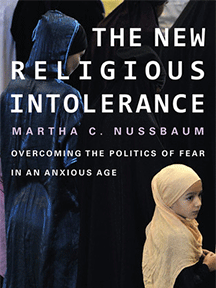By John P. McWilliams
Under what conditions does plausible fear of imminent, religion-based violence decline into widespread phobia? Or, to put it in specifically contemporary terms, how and why does rational fear of Islamic Terrorism degenerate into an Islamophobia that violates the admirable Western tradition of religious tolerance? What inner principles must now be summoned, what legal measures enacted, to protect individual rights of religious conscience? These kinds of perhaps unanswerable questions underlie every page of Martha Nussbaum’s eloquent appeal for basic human decency, toleration of difference, and the individual imagination to engage, even empathize, with the beliefs of persons of another religious culture. With no trace of moral self-righteousness, Nussbaum reminds her reader “when we encounter people who differ in religion, we ought to focus on ethical virtues of generosity, kindness and love, leaving the question of religious truth to one side in our civic interactions.”
The recent controversies that have stimulated Nussbaum’s reflections are the wearing and possible banning of the burqa, the banning of minarets on Swiss mosques, the rush to judge Anders Breivik’s killings in Norway as the work of an Islamic terrorist, and American outrage against the building of a purported mosque near Ground Zero. Over one hundred pages of the book are taken up with the narrative details of these controversies. Sometimes such detail is informative, and sometimes it reads as yesterday’s news. Fortunately, the details are surrounded with consideration of philosophic and legal contexts that sharpen the reader’s understanding of the headline incidents.
Nussbaum explores the narcissistic basis of fears arising from the threat of outsider attack. Popular fear arises from a real problem that is readily displaced onto look-alike people who are themselves not responsible, but who are imagined as dangerous enemies concealed in disguise (an alias, an Islamic veil). A provoking incident (“the startle effect”) leads the citizenry to overestimate the problem (“the availability heuristic”). The phrases and images that trigger fear, thanks to accelerating media access, can then spread almost instantaneously, without the pause of reflective restraint (“the cascade effect”). By these means popular fear has arisen in ways that increasingly threaten the right of individual conscience. Many Muslims, Nussbaum reminds us, died on 9/11; Breivik was an Islamophobe, not an Islamic terrorist; Park51, planned as an interfaith facility, was not even visible from Ground Zero.
Nussbaum’s expertise in the history of legal and philosophic thought underlies the book’s most original insights. She traces the rise of the individual’s right of conscience through Socrates, Roger Williams, Lessing, Washington, Jefferson, Mill, George Eliot and others, all the while reminding us of the difference between the nationalism of European states, based on romantic notions of folk cultural identity, and American nationalism, based upon universalist principles of individual rights. Nussbaum is especially perceptive about the distinction in American jurisprudence between the Lockean principle of equal rights of religious conscience (“the same laws must apply to all in matters touching on religious activities”) and the “Accomodationist” view, originating in George Washington’s letters, that there are instances in which the individual right of conscience must be protected by laws that accommodate particular minority practices and beliefs. The tension between the Lockean and Accomodationist view, Nussbaum argues, has always been with us and is as beneficial as it is inevitable.
So much, so good—or rather, so much, so excellent. Questions arise, however, from Nussbaum’s selection of incidents and from her rhetorical strategy. The wearing of a burqa, the building of a minaret and the founding of an interfaith facility that contains a Muslim prayer space, physically threaten no one. The suicidal aircraft of 9/11, hijacked by Islamic Terrorists, murdered thousands. Nussbaum rightly argues that fear of terrorist attacks is “entirely rational,” but the four incidents she has chosen to emphasize do not center upon murderous attacks. How then are the millions of Americans, who do not know Middle Eastern history, have never read the Quran and have never spoken with a Muslim, but who have been deeply affected by 9/11, to temper their fears and to discriminate between different kinds of seeming concealments? The causative tragedy, it would seem, has proven more dire in its effects than Nussbaum’s emphasis on four more recent incidents suggests. Recurring incidents linked to Islamic or Middle Eastern Terrorism (e.g. the Boston Marathon killings, which postdate Nussbaum’s book) re-stoke the flames of fear and outrage.
Nussbaum’s book focuses on questions of individual rights of religious conscience, but behind the fears she describes is an amalgam of religious, cultural, and racial difference that is extraordinarily difficult to sort out. Cultural, ethnic, and racial differences between the West and Mid-East, (differences which observers as unlike each other as Samuel Huntington and Sam Harris have emphasized), remain as important as issues of religious belief and religious practice definable under First Amendment language.
The climate of fear that Nussbaum describes reminds us that it is a great privilege for anyone to have the time to read and the opportunity to consider (let alone to review) her book. Are those of us who are prone to rush to judgment likely to be convinced by arguments for the rights of religious conscience based upon careful consideration of the probing questions of Socrates, the thought of Roger Williams, or the fiction of George Eliot? How many contemporaries truly care about their ideas? Nussbaum reminds us that “people usually don’t drop entrenched fears because they hear a good argument.” The New Religious Intolerance provides us with a very good argument indeed. Will those who read it be almost entirely those predisposed to accept the book’s argument? Is Martha Nussbaum preaching to the choir? One hopes it is only a sign of arrogance to think so.
John P. McWilliams (ΦBK, Princeton University, 1962) is a professor of humanities at Middlebury College and a resident member of the Beta of Vermont Chapter of Phi Beta Kappa.




